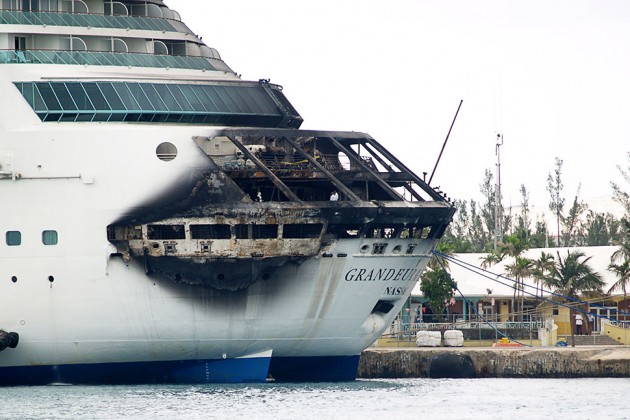
After a fatal capsizing and two high-profile fires aboard ships, observers began wondering whether cruise lines were operating with minimal regulatory oversight. An engine-room fire that leaves a 2,750-passenger ship adrift at sea for days? In 2013?
That incident aboard the Carnival Triumph—beamed round the world for days courtesy of CNN’s saturation-coverage strategy—followed the 2012 grounding of a European ship in which 32 people died. Three months after the Triumph blaze, meanwhile, a fire damaged Royal Caribbean’s Grandeur of the Seas. The incidents deeply embarrassed the industry, decimated Carnival’s financial results, and prompted politicians and regulators to make noise about tougher oversight. Late last year the industry’s two largest companies, Carnival (CCL) and Royal Caribbean Cruise Lines (RCL), hired retired military admirals to oversee their sea operations.
Safety became Job No. 1—and that means cruise lines are largely adopting practices pioneered by the aviation industry, which has boasted enormous improvements over the past three decades and made U.S. air travel the safest in the world.
“We certainly have had a wake-up call over the last couple years,” William Burke, chief maritime officer at Carnival, said on Wednesday near the end of a two-day forum that the National Transportation Safety Board convened in Washington, D.C., to review the cruise industry’s safety protocols. “So what I find is that people are really interested in getting better. And I find that across the board.” Burke joined Carnival in December after 35 years in the U.S. Navy, retiring as a vice admiral.
The grounding of the Costa Concordia near Italy showed cruise lines that their biggest safety risk is on the bridge. Crew errors on cruise ships mirror the airline industry’s experience of human error outpacing mechanical and other failures as the root cause of most mishaps in recent decades. A year after the Concordia disaster, the blaze aboard the Triumph demonstrated the inadequacy of some fire-suppression systems and led Carnival to embark on a $700 million program to upgrade its firefighting equipment and engine-room designs. Other cruise lines began similar, if less extensive, reviews and changes.
One concept in the safety regimen is called boat operations quality assurance, a system adopted from the flight operations protocol most airlines now use to oversee their flights. Another development borrowed from many airlines is a “no blame” reporting system, designed to allow cruise staff to identify deviations from protocols without fear of retribution. Some cruise lines are also contemplating an annual performance check for bridge officers, much the way the Federal Aviation Administration sends a “line check” pilot to ride in commercial airline cockpits to examine a crew’s performance on random flights.
Some larger cruise lines also are planning new systems to track bridge data from each cruise, analyzing deviations from normal procedures and why they occurred—the same type of systems airlines began using in the 1980s to increase flight safety. Over time, airlines shared their operations data across the industry and devised best practices—one of the hallmarks of the safety successes.
At Royal Caribbean, the industry’s second-largest operator, new ships are designed with a risk-based approach aimed at making the ship a “lifeboat,” in the sense that it’s better to keep passengers aboard when possible, according to William Baumgartner, the line’s senior vice president for marine operations. He joined the company in September after retiring from the U.S. Coast Guard as a rear admiral.
The sheer size of some new cruise vessels—Royal Caribbean’s two Oasis-class ships can each carry 5,400 passengers—alarms some regulators. Are they too big to sail? Can so many people be evacuated safely and in a timely manner? Is there a reasonable limit to how large a cruise ship should be?
Richard Fain, chairman of Royal Caribbean, says his company did not set out to build the world’s largest cruise ships when designing the Oasis-class ships. The size became a function of the experiences the company sought to include, such as rock climbing, a surfing wave pool, miniature golf, a re-creation of New York’s Central Park including 12,000 trees, a zip line, and a sky-diving experience. The line’s newest ship, Quantum of the Seas, which will make its debut in November, is one-third smaller.
“The rock-climbing wall was the dumbest idea I’d ever heard of,” Fain said during an interview on Wednesday. Dumb, that is, until a test aboard one ship demonstrated its immense popularity. Fain was converted: Each of Royal Caribbean’s 23 ships now sports such a wall. “Very few people go on the wall,” he says. “But everyone wants to watch.”
The extensive menu of onboard activities—the new Quantum ship will have bumper cars and a food truck—demonstrates the industry’s quest for its virtual holy grail: the first-time cruiser. Most people have never taken a cruise, and a fun time in a bumper car may prompt cruisers to extol the experience to a relative or neighbor, who may then decide to book. But a bumper car arena needs real estate—and all that real estate can make safety a more complicated task.
By Justin Bachman, Bloomberg Businessweek
For more cruise news & articles go to http://www.cruisecrazies.com/index.html
Re-posted on CruiseCrazies.com - Cruise News, Articles, Forums, Packing List, Ship Tracker, and more












Recommended Comments
Join the conversation
You can post now and register later. If you have an account, sign in now to post with your account.